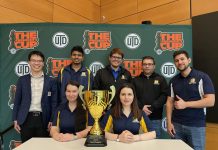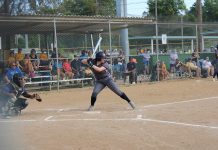In my four years as a Webster University student athlete, I don’t ever recall so many Webster sports teams playing so many difficult nonconference opponents. Need evidence?
On Sept. 2, the women’s soccer team fell 2-1 to Alma College, one of the best women’s soccer squads in NCAA Division III. Six days later, the Gorloks upended Elmhurst College, the No. 6-ranked team in the Central Region at the time.
The men’s soccer team tied Wheaton College, the No. 8 team in the country, on Sept. 22. Two weeks before that, the Gorloks fell 4-1 to Loras College, the No. 4 team in the nation.

The Webster volleyball team battled five tough opponents in a row — resulting in five straight losses — from Aug. 31 through Sept. 9. One of those squads was Millikin University, a top-tier Midwestern program that has compiled a 14-4 record this season.
This isn’t happening by accident. Webster coaches, who are responsible for scheduling nonconference contests, are clearly making a conscious effort to test their teams’ mettle early and often. The upshot: Webster’s teams will see a significant decrease in competition when they take on conference foes later in the year.
The potential downside, of course, is Webster teams may enter their St. Louis Intercollegiate Athletic Conference seasons with ugly records. Fortunately for this year’s crop of fall teams, that hasn’t really happened (women’s soccer is 6-2, men’s soccer is 3-3-1 and volleyball is 7-6).
So, what gives? Well, coaches are more inclined to schedule difficult nonconference slates when they know their teams will be able to handle increased levels of competition. The aforementioned fall teams are as good as they’ve been since 2009, when they all won SLIAC tournament championships on the same day.
Plus, Webster coaches know their squads won’t be prepared to compete in NCAA tournaments if they’re not used to facing top-notch teams.
Competing in and winning NCAA tournament contests needs to become a priority if Webster athletics is serious about consistently making noise at the national level. Scheduling tougher nonconference opponents is a great start.
And it won’t just apply to the fall teams, either. For the second year in a row, the baseball team will travel to Division-I Illinois State University. The Gorloks will also take on Marietta College, the two-time defending D-III national champs.
The men’s and women’s basketball teams, which combined for a 2-16 record against non-SLIAC teams last year, will both face powerhouse Washington University this season. The men will also play soon-to-be Division-II school Lindenwood University for a second straight year. Brad Soderberg’s Lindenwood team went 28-3 last season.
Other Webster squads, like the golf and men’s and women’s tennis teams, will navigate difficult spring schedules coming off their most successful campaigns in school history.
As an athlete and an ultra-competitive person, I love going up against the best collegiate teams and athletes in the country. It brings out the best I have to offer. I think a vast majority of Webster athletes would agree with that sentiment.
So when the women’s soccer team hosts No. 12-ranked WashU on Sept. 27 and the volleyball team hosts No. 1-ranked WashU on Oct. 3, those contests won’t be for naught, even if the Gorloks falter. Playing national championship-caliber schools like WashU is an important step in the development of Webster athletics, one that I hope will continue in future years.



